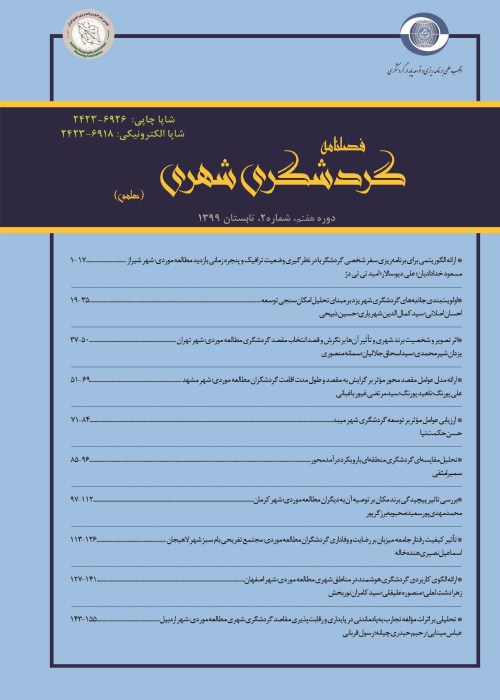Marketing of Cultural-Historical Capabilities of Urban Tourism Case Study: Gilan Province
The rapid growth of tourism as an industry has led many countries to view tourism as an important element in the development of national economy and so from the perspective of development, tourism is the biggest industry in the world, and many countries are considering this dynamic industry as the main source of income, employment, private sector growth and infrastructure development. In this regard, historical-cultural tourism is one of the forms of tourism that has long been considered important. In the short term, this type of tourism has led to the unity and connection of more different ethnicities, religions and cultures. One important issue is how to attract more people to a particular destination and what factors influence their behavioral responses that ultimately lead to revisit and positive recommendation advertising to attract new tourists, so it is one of the new advertising and marketing solutions in tourism and also is especially important in introducing and advertising cultural attractions and capabilities due to its dynamic nature. The importance and necessity of conducting research in the field of tourism industry is highlighted by the fact that this industry, as one of the most advanced industries in the world and as a strong driving force in social, cultural and economic fields, has the ability to form and transform various organs. In the meantime, Gilan province, with its valuable and precious ancient buildings and sites, including the Paleolithic, Neolithic, Bronze Age, Iron Age and Islamic period, as well as the historical sites of Gilan, including ancient hills such as Clores in Rostamabad and the cemeteries of Marian, Agh-e Uler, Deilman, the famous Marlik Hill each have the treasures of the heritage of our past and the value of human heritage with many cultural capabilities. However, due to weak marketing and word-of-mouth advertising, it has not been able to take advantage of these capabilities. Therefore, it is necessary to use its capabilities in the development of tourism, and one of the things that can provide the ground is the use of effective marketing tools and parameters of marketing and advertising. Thus, the present study was conducted to investigate the marketing of cultural-historical capabilities of Gilan tourism. Also, in this regard, it tries to give a logical answer to the following question:What are the effective variables and factors on the marketing of cultural-historical capabilities in Gilan province?
In the qualitative part, the data theory of the foundation has been used, which has been implemented based on the steps proposed by Glaser and Strauss. The statistical population includes all senior managers of the Cultural Heritage, Tourism and Handicrafts Organization of Gilan Province, as well as experts in the fields of business and tourism management and senior managers of municipal and governorate organizations, from which 15 people were selected. For the validity of the interview, the validation method was used by the members during the interview. To evaluate the reliability using the percentage of agreement method was done between the two coders (researchers) that the figure of 75% agreement showed the reliability of the qualitative part. MAXQDA software was exerted in order to analysis interviews.
In this section, with the aim of identifying the effective variables on the marketing segmentation of cultural-historical tourism, an in-depth and detailed review of the content of 15 domestic studies in the period 1391 to 1398 and 17 top foreign articles in the period 2012 to 2018, have been discussed and the main variables in these studies were extracted. The enumerated variables were provided to the participants so that the most important of these variables could be categorized in the main categories. At the end of the interviews and receiving the interviewers' point of view, the main components were identified with sub-categories and marker codes. These components are the historical branding of the destination (with sub-categories of historical characteristics of the destination and reflecting the historical aspect of the destination), cultural branding of the destination (with sub-categories of cultural characteristics of the destination and reflecting the cultural aspect of the destination), destination branding (with sub-categories of stakeholder management, participation in branding, destination brand image), tourism industry (with sub-categories of tourism infrastructure and tourism industry employees), environmental conditions of the country (with sub-categories of economic, political, cultural, social, legal, International factors), economic development (with sub-categories of economic prosperity), cultural development (with sub-categories of cultural prosperity), marketing of cultural capabilities (with sub-categories of cultural marketing), marketing of historical capabilities (with sub-categories of historical marketing). Each of these categories also has codes (indicators).
The research findings have identified nine main categories in the form of " destination historical branding", "destination cultural branding", "destination branding", "factors related to the tourism industry", "environmental conditions of the country", "marketing of historical capabilities", "cultural development", " marketing of cultural capabilities, " economic development" and this means that the marketing model of cultural-historical capabilities, tourism of Gilan are realized through these main categories, so that the historical and cultural characteristics of the destination are in the category of causal conditions. Marketing of cultural and historical capabilities are in the category of strategic conditions, among which the factors related to the tourism industry are the prevailing conditions and the environmental conditions of the country play a moderating role. Gilan cultural and economic development is one of the marketing consequences of cultural-historical capabilities of Gilan tourism.
- حق عضویت دریافتی صرف حمایت از نشریات عضو و نگهداری، تکمیل و توسعه مگیران میشود.
- پرداخت حق اشتراک و دانلود مقالات اجازه بازنشر آن در سایر رسانههای چاپی و دیجیتال را به کاربر نمیدهد.


